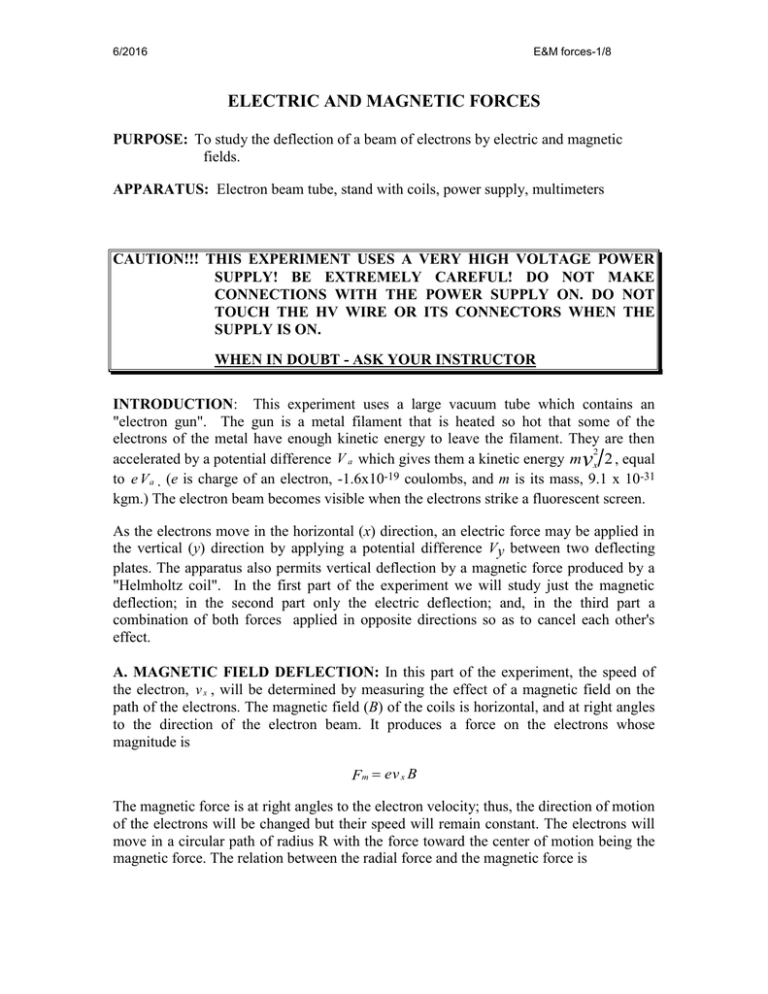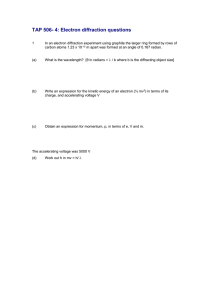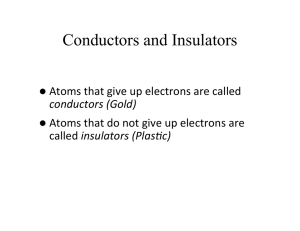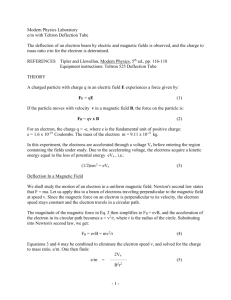6. Electric and Magnetic Forces
advertisement

6/2016
E&M forces-1/8
ELECTRIC AND MAGNETIC FORCES
PURPOSE: To study the deflection of a beam of electrons by electric and magnetic
fields.
APPARATUS: Electron beam tube, stand with coils, power supply, multimeters
CAUTION!!! THIS EXPERIMENT USES A VERY HIGH VOLTAGE POWER
SUPPLY! BE EXTREMELY CAREFUL! DO NOT MAKE
CONNECTIONS WITH THE POWER SUPPLY ON. DO NOT
TOUCH THE HV WIRE OR ITS CONNECTORS WHEN THE
SUPPLY IS ON.
WHEN IN DOUBT - ASK YOUR INSTRUCTOR
INTRODUCTION: This experiment uses a large vacuum tube which contains an
"electron gun". The gun is a metal filament that is heated so hot that some of the
electrons of the metal have enough kinetic energy to leave the filament. They are then
2
accelerated by a potential difference V a which gives them a kinetic energy m vx 2 , equal
to e V a . (e is charge of an electron, -1.6x10-19 coulombs, and m is its mass, 9.1 x 10-31
kgm.) The electron beam becomes visible when the electrons strike a fluorescent screen.
As the electrons move in the horizontal (x) direction, an electric force may be applied in
the vertical (y) direction by applying a potential difference Vy between two deflecting
plates. The apparatus also permits vertical deflection by a magnetic force produced by a
"Helmholtz coil". In the first part of the experiment we will study just the magnetic
deflection; in the second part only the electric deflection; and, in the third part a
combination of both forces applied in opposite directions so as to cancel each other's
effect.
A. MAGNETIC FIELD DEFLECTION: In this part of the experiment, the speed of
the electron, v x , will be determined by measuring the effect of a magnetic field on the
path of the electrons. The magnetic field (B) of the coils is horizontal, and at right angles
to the direction of the electron beam. It produces a force on the electrons whose
magnitude is
Fm ev x B
The magnetic force is at right angles to the electron velocity; thus, the direction of motion
of the electrons will be changed but their speed will remain constant. The electrons will
move in a circular path of radius R with the force toward the center of motion being the
magnetic force. The relation between the radial force and the magnetic force is
6/2016
E&M forces-2/8
m v 2x
R
e vx B
vx
or
e
BR
m
(1)
The magnetic field is produced by a pair of current-carrying coils. The field B produced
by the coils is proportional to the current I flowing in the coils. For the coils used for
this experiment use the relationship:
B = 4.23x10-3 x I.
where B is in Tesla and I is in amps. R is measured on the screen. The diagram on the
next page shows that, for the deflected beam, x, y, and R are related by
2
2
2
R Ry x
2
or
2
2
2
R R 2Ry y x
so that
R
x 2 y2
2y
(2)
electron beam
R
R-y
y
Fluorescent Screen
x
Figure 1:
The electron beam travels to the left and becomes visible on the fluorescent screen. The
circular motion is caused by the magnetic field directed into the page.
PROCEDURE: Study the vacuum tube, its contents and their connections to outside
voltage supplies. In the neck are a wire filament which will emit electrons when heated
red hot and an accelerating electrode in a sidewise cylinder. At the center of the glass
chamber, you will see a screen grid coated with a material which fluoresces under
electron impact and top and bottom horizontal metal plates for vertical electrostatic
deflection of the electron beam. On either side, in front and behind the glass chamber
are two coils of wire which produce a somewhat uniform magnetic field at the chamber's
center for magnetic deflection of the electron beam.
6/2016
E&M forces-3/8
Top Plate Voltage
Accelerating
Voltage
Fluorescent
Screen
Filament
Supply Don't
Change!
Electron "Gun"
"Helmholtz"
Coils
Bottom Plate Voltage
FIGURE 2: The electron beam tube.
In this apparatus has the same essential features as the display tubes in such devices as
oscilloscopes, computer monitors, and televisions.
For the electric deflection (Part B) and electric with magnetic deflection (Part C)
experiments high voltage applied to the accelerating electrode is the same voltage applied
to the electrostatic deflection plates.
Never alter the connections to the tube's filament.
Disconnect the high voltage cable from the top electrostatic deflection plate connector.
Let it lie on the table, but do not touch it when the supply is turned on. Disconnect the
ground cable from the bottom electrostatic deflection plate to the power supply. Next,
connect the alligator clip lead (jumper cable) to both the bottom and top plates to ensure
that charging of the plates by the beam does not occur which would produce an unwanted
electric field. Ask your instructor to check the connections before turning the supply on.
Once your set-up has been checked, recheck that the high voltage and coil current supply
control knobs are fully off (counter-clockwise). Only then turn the supply on.
The small multimeter should be set to a scale of 20 V and its reading should be multiplied
by 500 to get the high voltage output. (A reading of 2.0 volt means 1000 volts output.)
Increase the high voltage to 1000 volts. You should see a blue beam trace on the screen.
Observe the deflection caused by the magnetic field. Change the magnetic field by
varying the coil current. Observe the change in deflection.
Set the coil current to 0.30 amperes. For say x ≈ 5 cm or so, measure and record the y
deflection. Next, turn the voltage controls down, then turn off the power supply.
Reverse the direction of current through the coils, using the reversing switch. Repeat the
experiment with the same accelerating voltage, 1000 volts. The beam will be deflected in
the opposite direction because the magnetic field is now in the opposite direction.
6/2016
E&M forces-4/8
Measure the y deflection and calculate vx . Take an average of the two values of vx to
cancel the effects of the earth's magnetic field and any misalignment of the screen.
Repeat for an accelerating voltage of 800 volts, to obtain a new vx. How does vx depend
on the accelerating voltage? Explain your observation.
For future reference, remember the sense of deflection.
B. ELECTRIC DEFLECTION: In this part of the experiment, a y deflection is
produced by an electric field Ey . The vertical electric force is eEy and the vertical
acceleration is eEy/m . The force acts for a time t so that ( with vy 0 0 )
1
1 e Ey 2
y a y t2
t
2
2 m
The x-component of the velocity of the electrons is constant at a value vx , with x = vx t,
so that we can write
1 e E y x2
y
2 m v 2x
In this relation, all quantities except x and y are constant, so that the relation has the form
y = nx2, where n is a constant. This is the equation of a parabola.
The value of vx is given by conservation of energy (electric potential energy = kinetic
energy)
1
e Va m v2x
2
so we can substitute 2eVa for mvx2,
Ey 2
y
x
4V a
If the deflection plates were very large compared to their separation d, then Ey would be
given by Vy/d . Since this is not the case, Ey will be different by a correction factor k, so
that
Vy
(3)
Ey k
d
Because we use the same voltage for the acceleration (Va) as for the deflection (Vy) (Va =
Vy) we can therefore write
Vy 2
yk
x
4d V a
and, finally,
1 2
(4)
yk
x
4d
6/2016
E&M forces-5/8
PROCEDURE: Turn all voltages to zero and turn off the power supply. Disconnect
the jumper cable between the top and bottom plates and set it aside. Connect the high
voltage cable you previously set aside to the top plate and to the power supply. Connect
the ground cable that you previously set aside to the bottom plate and to the power
supply. Note that the same high voltage is applied both to the electron gun and to the
deflection plates. Do not turn the power supply on until the instructor has checked your
connections. Check that both the high voltage and the coil current control knobs are
turned fully counter-clockwise. Turn on the power supply and vary the high voltage.
Observe the deflected beam and record the values of y for x = 2, 3, . . . . cm. Remember
to convert everything to SI units (specifically meters); mixing units will give you an
erroneous result. Plot y against x2 and determine the slope k/4d and then k/d from the
graph. From this value, calculate k.
Why is the beam path independent of high voltage setting? Why does the trace intensity
increase with increasing high voltage? What are your units for k/d? Are these SI (m, kg,
s) units?
Show your values of k ( and of vx from Part A ) to your instructor.
C. MAGNETIC AND ELECTRIC DEFLECTION: In this part you will determine
what magnetic field applied perpendicularly to the electron velocity will offset the
electric field force to result in a straight path. That is for a certain E and B, there is only
one velocity v that results in a straight line, hence this is called a velocity filter (it is also
called a Wien filter, after Wilhelm Wien, 1864-1928). The equation giving this velocity is
v(x,E B) E B
This means the velocity in the x direction through a perpendicular E and B is the
magnitude, E, divided by the magnitude, B. [ The meaning of is called a "cross
product which is somewhat like the multiplication of perpendicular components. ] You
will have to figure out the direction of E and B to get this velocity filter to work.
PROCEDURE: Turn all voltages to zero and turn off the power supply. Connect the
coil supply wires so the deflection produced by the magnetic field will oppose that caused
by the electric field in the previous part. Turn on the power supply.
Starting with high voltage of 1,000 volts, increase the magnet coil current until the beam
is horizontal in the central portion of the coil. You may have to change the direction of
the magnetic field to accomplish this. If you do, please don't forget to turn the power
supply off before switching the current direction switch.
Repeat for other accelerating voltages up to the maximum output of your power supply.
Think about what you are doing in this part of the experiment - you are balancing the
electric and magnetic forces on the electron beam. For given values of E and B, should
this velocity depend on the charge of the electron?
6/2016
E&M forces-6/8
Calculate E from Eq. 3 using your experimental value of k/d (watch units) from above, B
from coil current I, and then, the expected velocities. How do the velocities compare with
those obtained in part A, for the same accelerating voltages?
CAUTION!!! THIS EXPERIMENT USES A VERY HIGH VOLTAGE POWER
SUPPLY! BE EXTREMELY CAREFUL! DO NOT MAKE
CONNECTIONS WITH THE POWER SUPPLY ON. DO NOT
TOUCH THE HV WIRE OR ITS CONNECTORS WHEN THE
SUPPLY IS ON.
WHEN IN DOUBT - ASK YOUR INSTRUCTOR
6/2016
E&M forces-7/8
ELECTRIC AND MAGNETIC FORCES
Names: ___________________________________________________
Section: ________ Date: _________
A. Magnetic deflection.
Velocity determination from v B
e
BR .
m
Make measurements for the maximum voltage your apparatus can supply, the minimum
voltage that still shows a trace, and two other voltages between the highest and lowest.
Voltage
Imagnet
B
volt
amp
tesla
y (x=.05m)
m
R
vB
m
m/s
+
Average =
+
Average =
+
Average =
+
Average =
You will use the same voltages in Part C.
B. Electric deflection. B = 0 ; Voltage: V = ________
Remember that the horizontal accelerating voltage is the same as the vertical deflecting
voltage. Make sure the magnetic coils are off. Turn the voltage to the maximum. The
k 2
circular path is defined by Eq. 4: y
x where d is the plate separation. Convert
4d
measurements to MKS units (namely, meters).
y
x
x2
From a linear graph of Eq. 4 plot y vs. x2 and determine the following with their units:
6/2016
E&M forces-8/8
slope {k/(4d)} = ____________ (k/d) = _____________ k = ____________
C. Wien (E B) velocity filter
Magnetic and Electric forces are equal and opposite.
Use the same voltages as Part A. Calculate the horizontal velocity from your data. Recall
that the velocity is given by vE B = E/B.
V
volt
E = (k/d)V
volt/m
IB
amp
B
tesla
vEB
m/s
On a linear graph, plot vE B vs. vB. When doing a linear fit, force the intercept to be
zero. Determine the slope = _________.
What does this graph mean?
What is the direction of the electric field, E ?
What is the direction of the magnetic field, B ?
What is the direction of the electrons, relative to E and B ?



